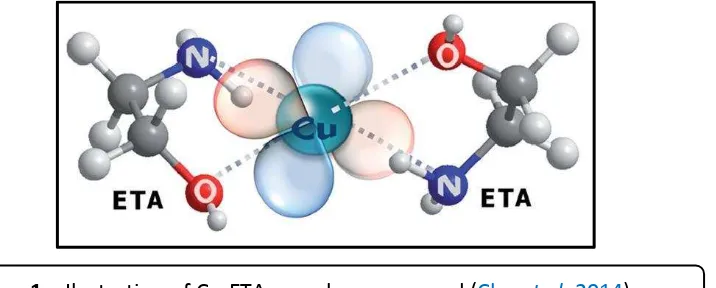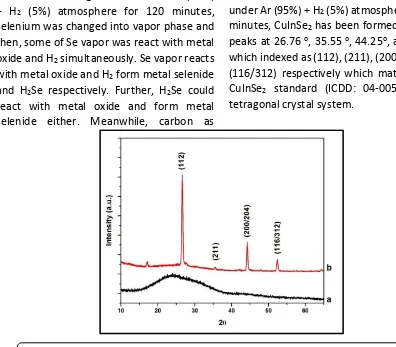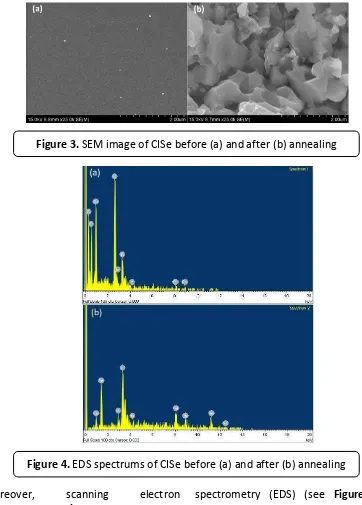Synthesis CuInSe
2(CISe) Thin Films Prepared from
Metal-Ethanolamine Complex Compound
Ersan Y. Muslih1,2,*, Agus Ismail2,3, Kyoo Ho Kim4
1Metalurgy Physics Laboratory, Mechanical Engineering Department, Faculty of Industrial Technology, Trisakti
University, Jalan Kyai Tapa No. 1, Grogol, Jakarta 11440, Indonesia
2Nano Center Indonesia, Jalan Raya Bogor KM 47, Cibinong, Bogor 16912, Indonesia
3Industrial Engineering Department, Engineering Faculty, Mercu Buana University, Jalan Raya Meruya Selatan,
Jakarta 11650, Indonesia
4School of Material Science and Engineering, Yeungnam University, 214-1 Daedong, Gyeongsan, Gyeongbuk
712-749, Republic of Korea *Correspondence: [email protected]
A B S T R A C T S A R T I C L E I N F O
CuI Se CISe thi fil as su essfull fa i ated f o oppe a d i diu salts ith etha ola i e as p e u so s. All of these p e u so s e e dissol ed a d fo ed o ple o pou ds ith etha ola i e si ulta eousl hi h deposited o soda li e glass spi oati g at p , follo ed heat t eat e t i the a ie t at osphe e at
oC fo i utes a d fi all sele izatio at 55 oC usi g
sele iu pellets u de A 95% + H 5% fo i utes to fa i ate CISe thi fil . Rea tio e ha is , st u tu e, o pholog a d he i al o positio also epo ted i this o k.
© 2017 Tim Pengembang Journal UPI
Article History: Received 03 May 2017 Revised 31 May 2017 Accepted 16 Jun 2017 Available online 01 Sep 2017
____________________
Keyword: Synthesis CuInSe2,
Ethanolamine as precursors, Complex compounds, Selenium pellets.
Indonesian Journal of Science & Technology
DOI: http://dx.doi.org/10.17509/ijost.v2i2
1. INTRODUCTION
CuInSe2 (CISe) is an ideal material for thin film solar cell application due to has optimum band gap (1.01 eV) and high absorption coefficient (105 cm-1) (Shay et al., 1973; J. Araujo et al., 2007). CISe thin films could be prepared by vacuum and non-vacuum methods. However, non-non-vacuum process such as chemical process is preferable due to low cost but still get high efficiency (Yin Liu et al., 2012). Although chemical process is preferable, this method using harmful solvents such as hydrazine and pyridine (C.J. Hibberd et al., 2010). Besides that, chemical process could leaves carbon in the thin film as residue (Shanza et al., 2016). In this work, CISe thin film has been fabricated by chemical process using ethanolamine as a solvent, deposited by spin coating and followed by selenization.
There the purpose of this study wa to synthesized CuInSe2 this film. The material was prepare from copper and indium salts with ethanolamine as precursors
2. EXPERIMENTAL DETAIL 2.1. Materials and Methods
In this work, the precursor solution was made from 0.1 M of copper (from copper(II) acetate) and 0.1 M of indium (from indium(III) chloride) All components were dissolved in 30% ethanolamine (ETA) in ethanol. The solution and exhibited a blue
color when using 1:1 Cu/In ratio. Moreover, 0.05 mL of precursor solution was deposited at 2000 rpm for 10 seconds on soda lime glass (SLG), which cleaned with acetone, ethanol, deionized water using ultrasonic for 15 minutes respectively and dried by nitrogen gas in order to eliminate contaminants further. Subsequently, deposited precursor was dried in tubular furnace at 200oC for 120 minutes until black shinny color was appeared. Repeating the deposition and the heat treatment appropriately can get desirable film thickness. Finally, the CISe thin film obtained by selenization in tubular furnace at 550oC using selenium pellets as selenium source under Ar (95%) + H2 (5%) atmosphere for 120 minutes. After selenization, the sample was cooled to room temperature under natural cooling condition.
2.2. Characterization of CISe thin film
The morphology was observed by scanning electron microscopy (SEM, Hitachi S4800, Japan). The chemical composition of the films was analyzed by energy dispersive x-ray spectrometry (EDS, Horiba, Japan). The crystal structures were determined by x-ray diffraction (XRD, PANalytical MPD, Netherlands). The absorption spectra were recorded using a UV-Vis-NIR spectro-photometer (Varian Carry 5000, U.S.A). The electrical properties were examined by Hall-Effect measurements using a Van der Paw method (HMS-3000, Ecopia U.S.A.).
DOI: http://dx.doi.org/10.17509/ijost.v2i2 p- ISSN 2528-1410 e- ISSN 2527-8045
3. RESULTS AND DISCUSSION
In this work, ethanolamine (ETA) and metal ions such as copper and indium could form a complex compound due to ethanolamine has free electron pair which donated to metal ions and form a coordination or complex bonding where the ETA acts as ligands and the metal ions act as a center atom. Since the unique structure of ETA, thus ETA could act as a chelating agent which illustrated as
Figure 1.
Moreover, at drying process, Cu-ETA and In-ETA complex compounds were decompossed under air atmosphere into metal oxide. Detailed reaction are
C2H7NO (aq) + Mx+ a → M[C2H7NO]x (aq) selenium was changed into vapor phase and then, some of Se vapor was react with metal oxide and H2 simultaneously. Se vapor reacts with metal oxide and H2 form metal selenide and H2Se respectively. Further, H2Se could react with metal oxide and form metal selenide either. Meanwhile, carbon as
residue reacted with H2 became methane gas and removed from thin film. Finally, metal selenide such as CuSe and InSe were coalesced into CuInSe2 as a final product. In other hand, this reaction mechanism shows that H2 acts as catalyst and as carbon remover simultanously. Detailed reactions are
Before annealing, x-ray defraction pattern (XRD) shows a broadened peak from 13.75o to 38.48o, which confirmed amorphous phase belong to carbon as dominant compound, while metal oxides due to in amorphous phase could not detected by XRD (see Figure 2). After annealed at 550 oC under Ar (95%) + H2 (5%) atmosphere for 120 minutes, CuInSe2 has been formed with four peaks at 26.76 o, 35.55 o, 44.25o, and 52.49o which indexed as (112), (211), (200/204), and (116/312) respectively which matched with CuInSe2 standard (ICDD: 04-005-3912) as tetragonal crystal system.
DOI: http://dx.doi.org/10.17509/ijost.v2i2
Moreover, scanning electron microscope (SEM) in Figure 3 shows that the morphology of precursor has smooth and tiny particles spread around the surface. Meanwhile, after annealing, shows the morphology, became larger and compact without shown hexagonal shape from copper was seen. It seems the reaction was going completely.
Organic residue was represented by carbon which existed in the thin film and could be determined by energy dispersive
spectrometry (EDS) (see Figure 4). The spectrum shows the proof of carbon existence in the thin film before annealing. In addition to carbon, also could be seen the spectrums of chloride from metal salts, while oxygen could represent of either organic residue or metal oxide. However, after annealing, the EDS spectrums of carbon, chloride and oxygen spectrums were no longer seen in the thin film. It seems they have been removed successfully during annealing
Figure 3. SEM image of CISe before (a) and after (b) annealing
DOI: http://dx.doi.org/10.17509/ijost.v2i2 p- ISSN 2528-1410 e- ISSN 2527-8045
% Atomic Ratio
Cu In Se C Cu/In (Cu+In)/Se
Before Annealing 19.61 16.34 0.00 64.05 1.20 -
After Annealing 15.68 11.60 24.58 0.00 1.35 1.11
EDS also could be used for determining the chemical composition of CISe thin film before and after annealing (see Table 1). Before and after annealing Cu/In ratio were 1.20 and 1.35 respectively. The slight enhancement of ratio probably due to diminished of indium in the thin film during annealing considering the melting point of indium (156 oC), which is below the annealing temperature. In other hand, copper is a stable material, thus during annealing it was not much diminished.
4. CONCLUSION
CuInSe2 (CISe) thin film has been synthesized successfully from metal salts and ethanolamine complex compounds by spin coating and followed by annealing method. Synthesis reaction mechanism of CISe also proposed in this work in order to explain whole process of synthesis from metal salts, complex compounds to CISe thin film. The structure of CISe thin film shows a tetragonal
and matched with CISe standard. Moreover, CISe thin film has a suitable chemical composition with no more carbon or organic residue in the thin film.
5. ACKNOWLEDGEMENT
This study was supported by the Basic
Science Research Program
(2013R1A1A2013408) and Center for Inorganic Photovoltaic Materials (No.2012-0001170) through the National Research Foundation of Korea (NRF) funded by the Ministry of Science, ICT and Future Planning. And also many thanks to Professor Kim Kyoo Ho for the encouragement, advices, and discussions.
6. AUTHORS’ NOTE
The author(s) declare(s) that there is no conflict of interest regarding the publication of this article. Authors confirmed that the data and the paper are free of plagiarism
7. REFERENCES
Araujo, J., Ortiz, R., López-Rivera, A., Ortega, J. M., Montilla, M., & Alarcón, D. (2007). Electrochemical growth of CuInSe2 thin film on different substrates from alkaline medium. Characterization of the films. Journal of Solid State Electrochemistry, 11(3), 407-412.
Cho, A., Song, H., Gwak, J., Eo, Y. J., Yun, J. H., Yoon, K., & Ahn, S. (2014). A chelating effect in hybrid inks for non-vacuum-processed CuInSe 2 thin films. Journal of Materials
Chemistry A, 2(14), 5087-5094.
Hibberd, C. J., Chassaing, E., Liu, W., Mitzi, D. B., Lincot, D., & Tiwari, A. N. (2010). Non‐vacuum methods for formation of Cu (In, Ga)(Se, S) 2 thin film photovoltaic absorbers. Progress
in Photovoltaics: Research and Applications, 18(6), 434-452.
DOI: http://dx.doi.org/10.17509/ijost.v1i2 p- ISSN 2528-1410 e- ISSN 2527-8045
Thin Film by Solvothermal and Spin-coating Process. Energy Procedia, 16, 217-222.
Rehan, S., Kim, K. Y., Han, J., Eo, Y. J., Gwak, J., Ahn, S. K., ... & Ahn, S. (2016). Carbon-Impurity Affected Depth Elemental Distribution in Solution-Processed Inorganic Thin Films for Solar Cell Application. ACS applied materials & interfaces, 8(8), 5261-5272.



